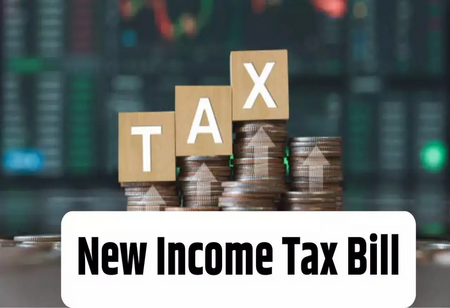The proposed new Income Tax Bill 2025 appears to have eliminated the concept of a 'nil TDS' certificate for both Indian taxpayers and non-residents, including NRIs, by removing two words - 'no deduction'. To understand how significant this change is, consider when a taxpayer requires a nil TDS certificate.
A taxpayer must apply for a nil TDS certificate online if he or she expects to receive income on which no income tax is due for any reason. So, if your actual income tax liability from any income is zero but Rs 1 lakh TDS is deducted on that income, you can apply for a nil TDS certificate, and if granted, zero TDS will be deducted. Similarly, if your tax liability is lower than the TDS amount, you can request a lower TDS deduction.
This is the change that the new tax bill for 2025 brings. If the current provision of this proposed bill is implemented as is, you will not be able to obtain a nil TDS certificate. However, you can still receive a lower TDS certificate. So, even if you are an NRI, you must file an income tax return (ITR) to claim the TDS that has been deducted, and if it exceeds your tax liability, you will be eligible for a tax refund. Earlier, with the nil TDS certificate, you could have avoided all of these procedures.
Read on to learn more about this change and how you can still manage the situation.
What did the new tax bill for 2025 propose?
Clause 395 of the new income tax bill 2025 states that if tax is required to be deducted on any income or sum under this Chapter, subject to the rules made under this Act,—
(a) The payee may apply to the Assessing Officer for a deduction of tax at a lower rate; and
(b) If the Assessing Officer is satisfied that the payee's total income justifies a lower deduction, he or she shall issue an appropriate certificate; and
(c) When a certificate is issued under clause (b), the person responsible for paying the income or amount must deduct the tax at the rate specified in the certificate during its validity.
Section 197 of the Income Tax Act of 1961 states:
Subject to rules made under sub-section(2A), where, in the case of any income of any person or sum payable to any person, income-tax is required to be deducted at the time of credit or, as the case may be, at the time of payment at the rates in force, and the Assessing Officer is satisfied that the total income of the recipient justifies the deduction of income-tax at any lower rates or no deduction of income-tax, as the case may be, the Assessing Officer shall, on an applicable.
What does the new change in the new tax bill 2025 mean for NRIs and Indians?
According to Prashant Khatore, Tax Partner at EY India, the new Income Tax Bill, 2025, allows both Indians and NRIs to obtain a lower TDS certificate rather than a nil TDS certificate.
"It should be noted that clause 395 of the proposed Income Tax Bill, 2025, provides for a lower TDS certificate that the payee can obtain in the event of any payments. The application under clause 395 is not limited to specific sections, as it is in the current section 197 of the Income Tax Act of 1961. Furthermore, the current language of the proposed bill does not allow for a nil TDS. This means that under the new bill, the payee may be unable to obtain a certificate of zero withholding from the payer," Khatore explains.
Suresh Surna, a Chartered Accountant, concurs with "The new income tax bill, 2025 proposes a crucial shift which provides that only lower TDS rate certificates will be permitted under the new Section 395, effectively removing the option for obtaining a NIL tax deduction certificate, regardless of the taxpayer's income profile."
What is the impact of the new change proposed in the 2025 income tax bill on NRIs and Indians?
We spoke with several experts about the potential impact of this proposed change in the language of the new income tax bill, 2025, on NRIs and Indians. This is what they said:
Though changes in TDS laws bring uniformity, they also introduce a more restrictive tax framework
Surana says, "The shift from Section 197 of the Income-tax Act, 1961, to clause 395 of the Income-tax Bill, 2025, introduces a more uniform but also more restrictive framework for tax deduction at source (TDS)."
Get a lower TDS certificate for all payments rather than the specified payments earlier
According to experts, lower TDS certificates were previously limited to specified payments under the Income Tax Act of 1961; however, no such restrictions apply under the new tax bill of 2025.
According to Khatore of EY India, "Under the new tax bill, 2025, as the application of lower TDS is not limited to certain specified payments, the new bill expands the scope of obtaining a lower TDS withholding certificate." If there is a valid reason for lower TDS, the facility is extended to all payments."
Surana agrees with Khatore and adds that the proposed change to include all payments as eligible for a lower TDS certificate broadens the scope of the lower TDS deduction. "On the other hand, the new income tax bill, 2025 broadens the scope of who can apply for lower TDS certificates to include all types of income, including those previously excluded (e.g., benefits under Section 194R or foreign interest under Section 194LC), which are now eligible for lower TDS certificates. This reduces uncertainty and promotes greater consistency in TDS administration across different income brackets," says Surana.
Ankit Namdeo, Managing Partner at ANK Advisors, agrees with Surana and Khatore and adds: "The proposed expansion of the nil/lower withholding tax certificate to include all payments, from the extent scope of'specified receipts' would enable a solution-oriented approach for various types of transactions and capital receipts such as liquidated damages, etc."
No relief from TDS through nil certificates means the blocking of money
Khatore states: "This proposed change may lead to higher blockage of working capital as going forward the payer may have to withhold some tax which was earlier exempted due to availability of nil withholding tax."
According to Surana, the elimination of the option to obtain a NIL deduction certificate means that even taxpayers who have no taxable income (due to exemptions, losses, or lower thresholds) will face some level of tax withholding.
"This could affect start-ups and early-stage businesses that are losing money, non-residents who earn exempt income or income that is less than the taxable limit, tax-exempt entities (such as some charitable trusts and pension funds), and so on." According to Surana, such taxpayers will now have to file returns to claim refunds, which may put a strain on their liquidity/cash flow.
Khatore elaborates: "Taxpayers who would be having losses or tax exemption and consequently may not be having any tax outflow, would not be able to obtain nil withholding under the new law."
The government wants to track the transactions, so no nil TDS certificate
According to Ankit Jain, Partner at Ved Jain and Associates, "Tax Deducted at Source (TDS)" plays a critical role in the tax system. It enables the government to collect taxes on a regular and timely basis, even before people file their tax returns. But, more importantly, TDS provides the government with a clear picture of how much income a person or business earns. This is because deducting TDS requires not only paying tax to the government but also reporting the income from which the tax was deducted. That income trail becomes a valuable tool for identifying cases where income is not properly disclosed.
This is most likely one of the primary reasons why the government is considering eliminating the Nil TDS Certificate in the new Income Tax Bill of 2025. Under current law, a person can apply for a certificate that allows the payer to deduct no tax if their income is less than the taxable limit. However, the government views this as a loss of valuable data. Without a TDS deduction, no income is reported.
Instead of a complete waiver, many tax officers have already taken a practical approach, allowing a very small rate of deduction, such as 0.1% or even 0.01%. While such small amounts have little impact on the taxpayer's liquidity, they ensure that the transaction is captured and reported. This allows the tax department to get a complete picture of the taxpayer's income, even if no actual tax is owed.
So, if the new tax law replaces the Nil certificate with a very low TDS rate, the goal is not so much to collect more tax as it is to keep the income trail transparent. In the long run, this leads to a fairer and more transparent tax system for all.


